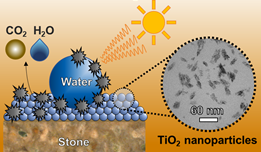Advances in the application of nanomaterials for natural stone conservation
DOI:
https://doi.org/10.21809/rilemtechlett.2022.159Keywords:
nanomaterials, cleaning, consolidation, protection, natural stoneAbstract
The unpredictable effects of climate change impose the safeguarding of Cultural Heritage (CH) with effective and durable materials as a vital solution in the invaluable socioeconomic resource of CH. Conservation products and methodologies are addressed under recent advancements in colloidal science providing multi-functional solutions for cleaning, consolidation, protection, and monitoring of the architectural surfaces. Nanoscience significantly contributes to enrich the palette of materials and tools that can guarantee an effective response to aggressive environmental agents. Nanostructured multi-functional nanoparticles, nanostructured fluids, and gels for stone conservation are reviewed and future perspectives are also commented. The stability and high flexibility in designing tailored made nanoparticles according to the specific characteristics of the substrate enable their use in a variety of applications. Stemming from the well-performed in lab applications with nanomaterials, the testing onsite and the monitoring of their effectiveness are of crucial importance, considering also the constructive feedback from conservators and heritage stakeholders that can unquestionably contribute to the improvement and optimisation of the nanomaterials for CH protection.

Downloads
Published
How to Cite
Issue
Section
License
Copyright (c) 2022 Francesca Gherardi, Pagona Noni Maravelaki

This work is licensed under a Creative Commons Attribution 4.0 International License.
Authors retain copyright of the articles published in RILEM Technical Letters and grant the journal the right of first publication with open access. The work is simultaneously licensed under Creative Commons Attribution 4.0 International License (CC BY 4.0) that allows others to share and adapt the work under the following terms: 1) a proper attribution is given in a form of bibliographic record with the DOI link directing to RILEM Technical Letters; 2) a link to the license is provided; 3) the changes (if any) are indicated.









